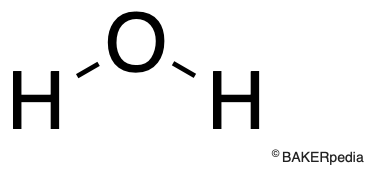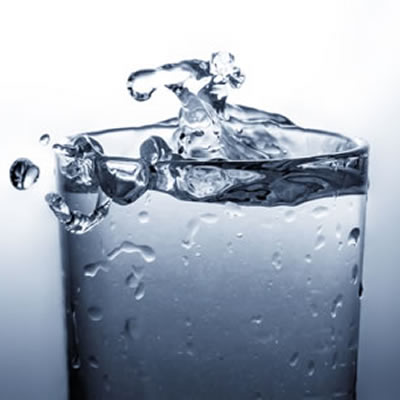Water
Also Known as H2O
What is Water?
Water is a basic component of living matter and is essential to cooking and baking processes. In baking, it helps with hydration of gluten and starch molecules and dissolving salts, baking powder, sugar and others.
At room temperature, it is an odorless, colorless, tasteless liquid when pure.1 The three states of water are:
- Solid ice at 0°C (32°F)
- Liquid
- Gas vapor at 100°C (212°F)
Chemical structure

Origin
Water for baking manufacturing is obtained from local sources of potable sources conditioned for human consumption.
Function
Water has several functions in baking:1
- Solvent: dissolves salts, sugars and baking powder so they can perform their roles as fermentation regulators, tenderizers, stabilizers and leavening.
- Hydration: hydration of gluten is essential for dough network formation and starch gelatinization.
- Yeast-activation: it is required to activate yeast and allow fermentation to occur.
- Temperature adjustment: it can be added to control the temperature of batters and doughs. Cold water is added to pie dough to keep fats solid while warm water is used to activate yeast.
- Viscosity and consistency: addition of water affects dough and batter viscosity. Consistency accomplished with the addition of water that defines whether its a batter or a dough.
- Release of starch granules in wet milling: water’s role in the dissociation of the endosperm cell content results in the release of starch granules from the gluten web.
- Amount of free water can also impact baked goods’ shelf life and microbial growth.
Sourcing of water
Water can be obtained from surface or groundwater sources with the latter is of better quality and requires less treatment. Typical reservoir conditioning involves:2
- Removal of large particles
- Coagulation/flocculation: to destabilize particles and promote aggregation
- Sedimentation: settling of the aggregates
- Filtration: removal of aggregates through sand filtration
- Carbon filtration: removal of volatile organic compounds
- Disinfection: elimination of pathogenic microorganisms with chlorine
Potable water quality parameters for baking bread:3
| Parameter | Value |
| pH | 6.5 – 6.8 |
| Total Dissolved Solids (ppm) | 150 – 500 |
| Total Hardness (ppm) | 50-100 |
| Total coliforms | 0 |
Hardness of water can be managed at the plant with softeners or ion exchange membranes.2
Types/variations
Water can be classified according to its calcium and magnesium content as:3
- Hard: high mineral content above 100 ppm. It strengthens the dough and increases the fermentation rate.
- Medium hard: medium mineral content between 50-100 ppm. Best suited for baking.
- Soft: low mineral content. It produces sticky, soft and slack dough and decreases fermentation rate. Yeast-leavened products may require addition of nutrients to improve fermentation.
Application
Water has a wide variety of applications in baked goods. All types of baked goods have water as an ingredient in direct or indirect form. It can be in the form of free or bound.
The moisture content of some typical bakery products is shown in the following table:1
| Baked good | Moisture content | Water activity | Characteristics |
| Bread | 38-44% | Intermediate |
Moisture content varies according to crust character. Differential moisture content between crust and crumb. |
| Cake | 15-30% | Intermediate |
Increasing moisture higher perception of freshness. Affects crumb texture perception. |
| Biscuit and cookies | 5-10% | Low |
Crisp and dry May soften due to water absorption from the environment. |
| Pastries | Máx 15% | Low |
Crisp and dry May soften due to moisture migration from fillings. |
Regulations
Water quality standards for baked goods manufacturing according to the FDA are regulated by the drinking water standards of the Environmental Protection Agency (EPA).4
The European Union regulates water quality for food production with the Council Directive 98/83/EC.5
The following table shows water quality requirements for US and EU:6
| Parameter | FDA | European Commission |
| pH | 6.6 – 8.5 | 6.5 – 9.5 |
| Total Dissolved Solids (ppm) | <500 | 1600 |
| Turbidity (NTU) | <5 | <1 |
| Total Hardness (ppm) | – | – |
| Total coliforms | 0 | 0 |
References
- Figoni, P. How Baking Works: Exploring The Fundamentals Of Baking Science. 3rd ed., John Wiley & Sons, Inc., 2011.
- Kulp, K and Ponte, J.G . Handbook of Cereal Science and Technology, revised and expanded. 1 st ed., CRC Press, 2000.
- Worch, E. Drinking water treatment: an introduction. 1 st ed., Walter de Gruyter GmbH & Co KG, 2019.
- “Guide To Minimize Microbial Hazards For Fresh Fruits And Vegetables”. U.S. Food And Drug Administration, 2020, https://www.fda.gov/regulatory-information/search-fda-guidance-documents/guidance-industry-guide-minimize-microbial-food-safety-hazards-fresh-fruits-and-vegetables#ii . Accessed 15 Aug 2020.
- European Commission (EC). Council Directive 98/83/EC on the quality of water intended for human consumption: calculation of derived activity concentrations Official Journal of European Communities, 1998.
- Environmental Protection Agency (EPA). “2018 Edition of the Drinking Water Standards and Health Advisories Tables”.2012 Drinking Water Standards and Health Advisories, 2018.


